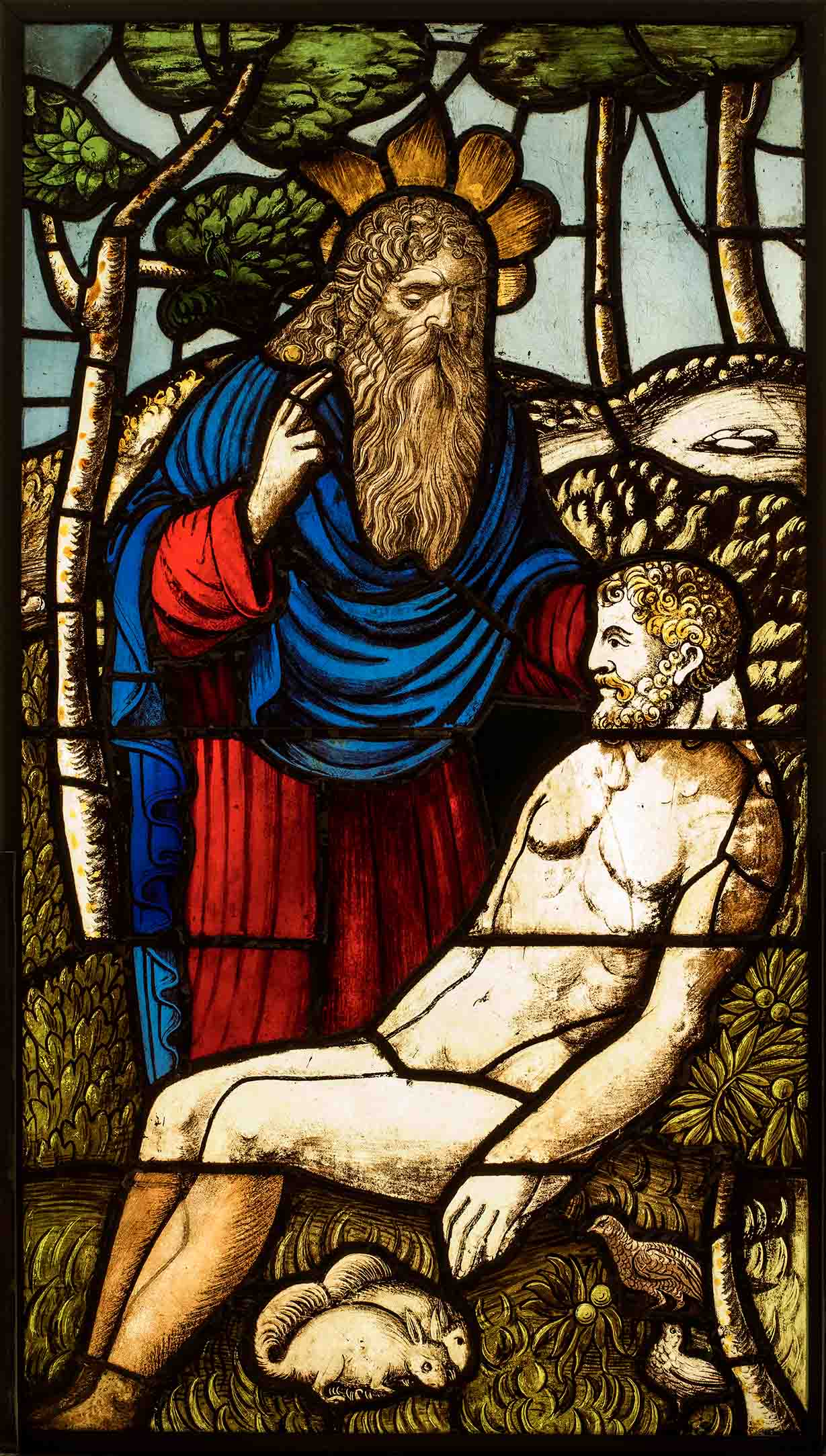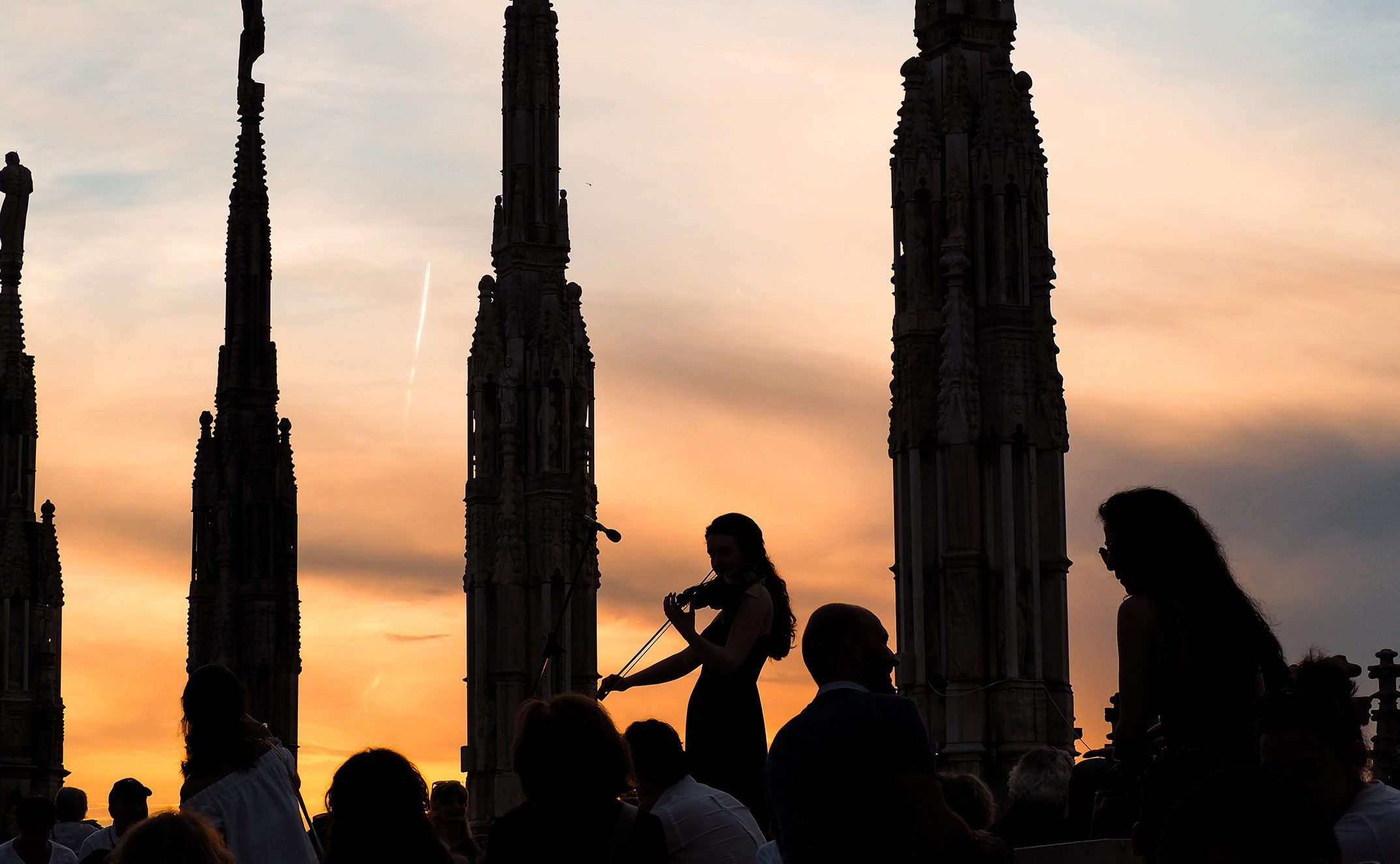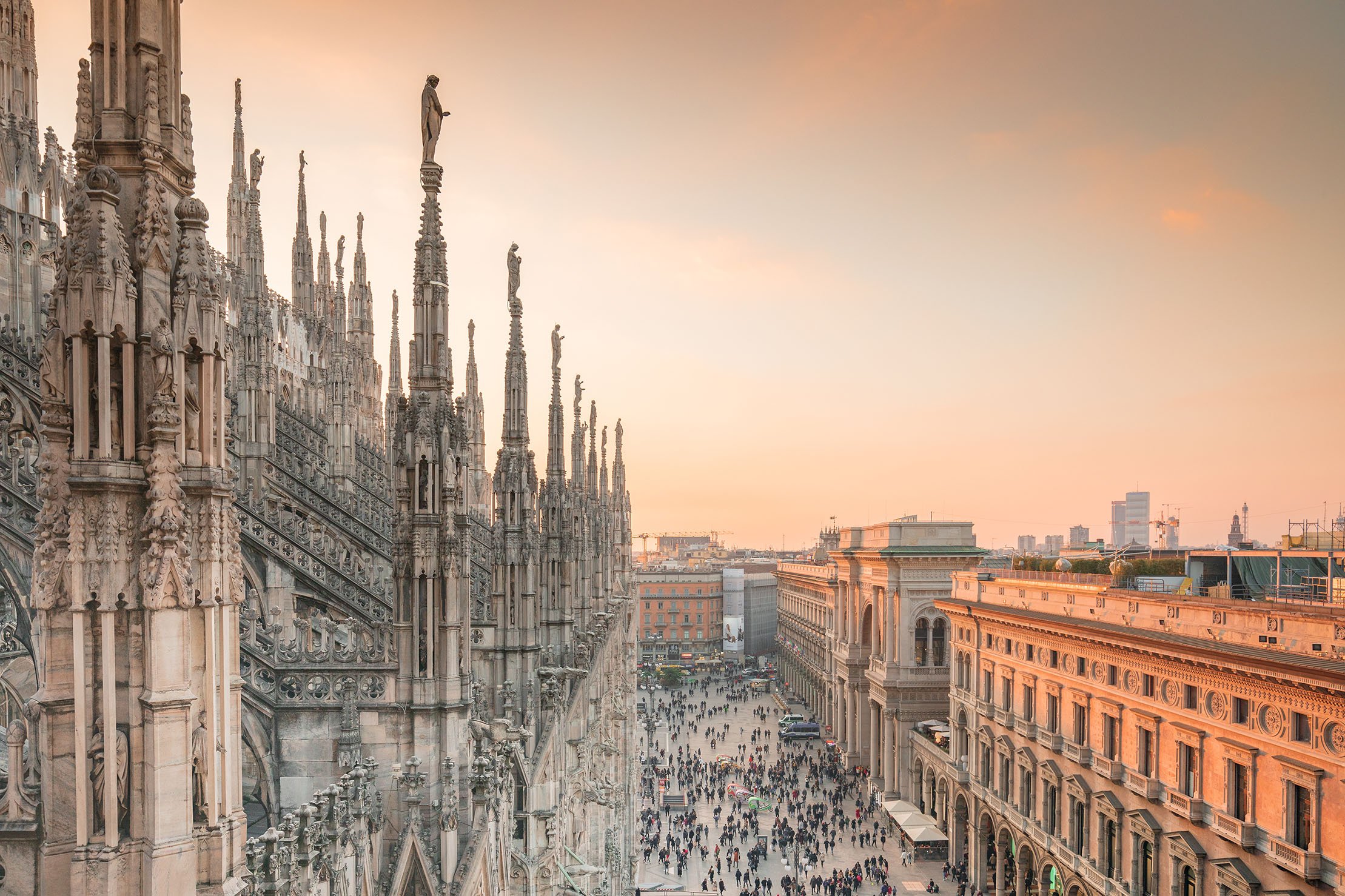DescriVedendo Museo del Duomo CLICCA SULLA BANDIERINA PER ASCOLTARE L’AUDIODESCRIZIONE DELL’OPERA
CLICCA SULLA BANDIERINA PER ASCOLTARE L’AUDIODESCRIZIONE DELL’OPERA
“La creazione dell’uomo”
“La creazione dell’uomo” è un’opera realizzata fra il 1549 e il 1557 dal vetraio Corrado de Mochis su cartone preparatorio di Giuseppe Arcimboldi.
Le sue misure sono circa 120 centimetri in altezza per 68 centimetri in larghezza e si presenta quindi come un rettangolo con il lato più lungo inverticale.
Si tratta di un “antello”, ovvero di un pannello in vetro, costituito da vari pezzi di forme e dimensioni diverse accostati tra loro e piombati a formare una vetrata. Per dipingere i dettagli, quali i volti, le architetture, le pieghe delle vesti, e creare i chiaroscuri, veniva utilizzata la grisaglia, un composto di ossidi di ferro e di terre mescolati con silice o vetro. Per conferire diverse tonalità di colore, poteva inoltre essere aggiunto uno speciale smalto, il giallo d’argento.
L’opera è stata realizzata in stile realistico: l’artista ha cioè riprodotto proporzioni, forme e colori, similmente a come li percepisce l’occhio umano.
Fa parte di un trittico incentrato su episodi citati nell’Antico Testamento, esposto nel Museo del Duomo nella sala dedicata all’arte vetraria, dove figura assieme a “La creazione del Firmamento” e “La creazione degli animali”, opera degli stessi autori.
“La creazione dell’uomo” si trova a sinistra rispetto agli altri due pannelli.
Il soggetto è Dio che sorregge la testa di Adamo, semisdraiato nudo davanti a lui, in un ambiente con flora e fauna.
Dio è raffigurato al centro della scena, frontalmente e in piedi, visibile fino alle ginocchia. Il suo volto è quello di un uomo anziano, con rughe sulla pelle. Lo sguardo è rivolto in basso verso Adamo e le sopracciglia aggrottate in segno di grande concentrazione. La bocca è nascosta da una lunga e folta barba ondulata che si fonde con la capigliatura riccioluta, estesa fin sotto le spalle.
Intorno alla testa è visibile un’aureola dorata a raggiera simile alla corolla di un fiore. La testa e le spalle sono leggermente chinate in avanti.
Il braccio destro è piegato al gomito e l’avambraccio tenuto alzato a compiere con le dita della mano un gesto benedicente. Il braccio sinistro invece è proteso in avanti e con la mano passa sotto il collo a sorreggere la testa del primo uomo a cui sta dando la vita. Dio indossa una tunica rossa a maniche lunghe sopra la quale poggia un ampio mantello blu drappeggiato, visibile fino al ginocchio.
Davanti a Dio e in diagonale, con la testa davanti alle gambe del suo creatore e i piedi in basso a sinistra, Adamo è semidisteso su una radura erbosa. Di lui vediamo il volto che rivela il lato sinistro e il corpo girato più di tre quarti, che mostra anche la parte anteriore. È un giovane uomo con capelli e barba biondi corti e ricci che contornano un volto visibile di profilo dai lineamenti regolari, dall’espressione seria e lo sguardo rivolto davanti a sé. Il busto è tenuto sollevato dalla mano di Dio che gli passa sotto la testa, le braccia rilassate lungo i fianchi, le gambe accostate e flesse al ginocchio con i piedi che terminano vicino all’angolo inferiore sinistro dell’antello. Più centralmente in basso, poco distanti dal suo corpo sono visibili due scoiattoli e due uccelli.
Lo sfondo della scena è costituito da una radura ricoperta d’erba e bassi cespugli. Un albero frondoso con fusto alto e sottile è visibile sulla sinistra, e altri due più sullo sfondo. Dietro di essi, splende un cielo azzurro.
La scena è molto luminosa, con una fonte di luce non visibile proveniente da ore 11 che colpisce in particolare il corpo di Adamo e la mano destra benedicente di Dio, ponendole in risalto. Brillanti tutti i colori, fra i quali assumono forza il rosso e il blu degli abiti indossati da Dio.
La descrizione morfologica redatta e validata tra settembre e novembre 2023, certificata DescriVedendo, è stata realizzata dal Team DescriVedendo, con Associazione Nazionale Subvedenti ETS, in collaborazione con Veneranda Fabbrica del Duomo.
DescriVedendo Duomo Museum
CLICK ON THE FLAG TO LISTEN THE AUDIODESCRIPTION
“The Creation of Man”
“The Creation of Man” was produced between 1549 and 1557 by the glassmaker Corrado de Mochis and based on a preparatory cartoon by Giuseppe Arcimboldi.
It is around 120 centimetres high and 68 centimetres wide and so forms a rectangle, with the vertical being the longest side.
This is an “antello”, that is, a glass panel made up of various pieces of different shapes and sizes put together and joined with lead to form a stained-glass window. To paint the details, such as faces, buildings, the folds of clothes, and to create chiaroscuro, grisaille was used, a compound of iron oxides and earth mixed with silica or glass. To produce different shades of colour, a special enamel known as silver yellow could be used.
The style of the work is realistic: that is, the artist has reproduced proportions, shapes and colours in the same way as the human eye perceives them.
It is part of a triptych centred on episodes from the Old Testament, exhibited in the Museum of the Duomo in the room dedicated to the glassmakers’ art, where it appears along with “The Creation of the Firmament” and “The Creation of the Animals” by the same artist.
“The Creation of Man” is on the left of the two other panels.
The subject is God supporting the head of Adam, half reclining, naked, in front of him in a place with flora and fauna.
God is depicted at the centre of the scene, frontally and standing, and can be seen down to the knees. His face is that of an old man with wrinkled skin. His gaze is turned down towards Adam and the eyebrows are knitted together in a sign of great concentration. The mouth is concealed by a long, thick wavy beard that merges with the curly hair that reaches below the shoulders. A golden halo around the head gives off rays of light, like the corolla of a flower. The head and shoulders are slightly bent forward.
The right arm is bent at the elbow and the forearm is raised up to carry out an act of blessing with the fingers of his hand. The left arm is held out in front and the hand is passed under the neck to support the head of the first man to whom he is giving life. God wears a red, long-sleeved tunic under a large blue draped cloak, visible down to the knee.
In front of and diagonal to God, with his head at the level of the legs of his Creator and his feet in the lower left, Adam is reclining in a grassy glade. We see the left side of his face and the body turned three-quarters of the way round, displaying the front. He is a young man with short, curly blond hair and a beard that surround a face seen in profile, with regular features, a serious expression and looking straight ahead. His torso is raised by the hand of God, which passes under his head, the arms laying at the sides, legs together and bent at the knee, with the ends of the feet near the lower left corner of the antello. More centrally, below, two squirrels and two birds can be seen near his body.
In the background of the scene, there is a glade covered in grass and low bushes. A leafy tree with a tall, thin trunk can be seen on the left, and there are another two further in the background. Behind them, a blue sky shines.
The scene is very bright with an invisible light source in the direction of 11 o’clock that, in particular, strikes Adam’s body and the blessing right hand of God, emphasising them. All the colours are vivid but the most striking are the red and blue of the robes worn by God.
The morphological description drawn up and validated between September and November 2023, certified by DescriVedendo, was created by Team DescriVedendo with the National Association of the Visually Impaired ETS, in collaboration with Veneranda Fabbrica del Duomo di Milano.

Tutti i diritti riservati – © Veneranda Fabbrica del Duomo di Milano



